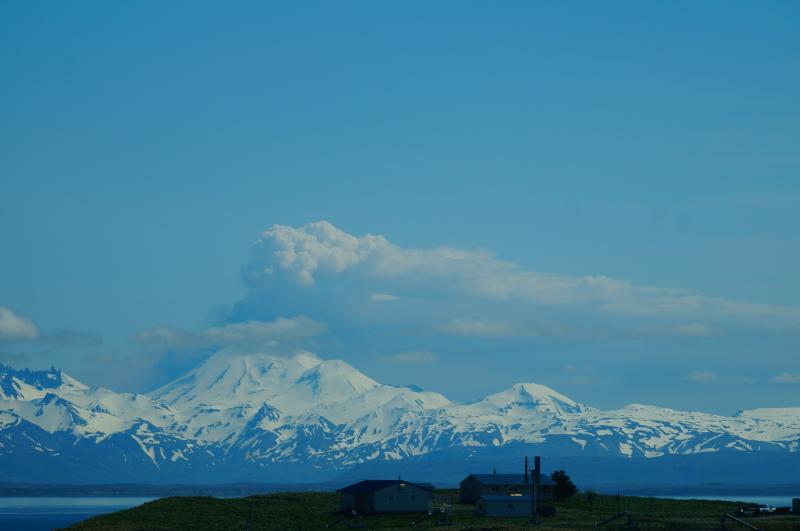
Pavlof volcano in eruption, June 2, 2014 view from Cold Bay. Photo courtesy Robert Stacy.
Volcano(es): Pavlof
Photographer: Stacy, Robert
URL: avo.alaska.edu/image/view/58371
Pavlof 2014/5
From Cameron and others, 2017: "The first eruptive episode at Pavlof in 2014 began at about 19:00 UTC (11 a.m. AKDT) on May 30, based retrospectively on a pulsating tremor-like signal in 1-5 Hz bandpass seismic data. The seismicity was visible across the Pavlof seismic network. By 07:22 UTC on May31 (11:22 p.m. AKDT, May 30), satellite data showed a strong thermal signal, suggestive of lava at the surface. AVO upgraded the Aviation Color Code and Volcano Alert Level from GREEN/NORMAL to ORANGE/WATCH at 19:36 UTC (11:36 a.m. AKDT) on May 31. Subsequent analysis indicated that the opening phase of the eruption on May 31 was recorded on an infrasound network on Akutan Island about 278 km (173 mi) southwest of Pavlof. AVO received the first pilot reports of ash emission on June 1, indicating distinct ash clouds as high as about 3km (2 mi) ASL, drifting north-northeast as much as 80 km (50 mi) beyond the summit of the volcano. Lahar (mud flow) signals were evident in seismic data from station PV6 by late in the day on June 1. These initial flows lasted for 15-30minutes each, and were preceded by sustained low-level pulsatory tremor.
"At about 01:30 UTC, June 3 (5:30 p.m. AKDT on June 2) , the amplitude of the seismic tremor increased significantly; Web camera, satellite views, and several pilot reports all indicated that a period of robust ash emission was underway. At this point, AVO upgraded the Volcano Alert Level and Aviation Color Code from ORANGE/WATCH to RED/WARNING, where it remained for about the next 24 hours. During this period, the volcano erupted almost continuously, and observers in Cold Bay reported incandescence at the summit, seismic stations recorded lahar signals, seismic tremor remained at high levels, and strong thermal signals were evident in satellite data. The highest ash plume generated during this period of heightened activity reached as high as 6,700 m (22,000 ft) ASL (based on pilot reports) and extended about 100 km (60 mi) to the southeast over Sand Point and Unga Island. Although there were no reports of ashfall in nearby communities on June 2-3, significant SO2 emissions were detected in infrared atmospheric sounding interferometer (IASI) satellite data on June 3.
"Beginning at about 06:30 UTC on June 3 (10:30 p.m. AKDT on June 2), the overall level of seismicity began to decrease slowly, and at 01:54 UTC on June 4 (5:54 p.m. AKDT on June 3), AVO downgraded the Aviation Color Code and Volcano Alert Level to ORANGE/WATCH in response to the decreased levels of seismicity. Although the tremor level was reduced, the overall level of seismic activity remained relatively steady throughout the day on June 3, and was associated with a mostly steam-and-gas plume, containing only minor amounts of ash reaching as high as 5,900 m (19,600 ft) ASL and drifting to the south. Trace amounts of fine ash were reported at the Sand Point airport on June 3-4, resulting in cancelation of flights to Sand Point on the morning of June 4. As many as five flights to Cold Bay and nine flights to Dutch Harbor also were canceled on June 3-4 because of the risk of encountering ash. Local commuter air service was suspended as well during this time, affecting air travel to King Cove and False Pass. Flight cancellations continued into June 5, disrupting flights to and from Dutch Harbor and Cold Bay.
"The activity on June 2-3 was characterized by periods of vigorous lava fountaining that resulted in the accumulation of lava spatter on the upper northern flank of the volcano. This accumulation resulted in the formation of a spatter-fed lava flow that eventually extended about 4.7km (2.9 mi) downslope. At other times during the eruption, accumulations of spatter grew and built unstable piles of hot, fragmental material that occasionally collapsed and formed hot granular avalanches that flowed rapidly down the northern flank of the volcano for several kilometers. These hot granular rock avalanches swept across snow and ice, producing impressive steam plumes and generating melt water that led to the formation of lahars in some of the main drainages on the northern flank of the volcano. No ash or steam plumes were evident in satellite data after June 4, although seismic data recorded two explosions on the morning of June 5, and the World Wide Lightning Location Network (WWLLN) detected lightning near Pavlof from 10:16-10:59 UTC (2:16-2:59 a.m. AKDT) on June 5. Meteorological lightning is unusual in this part of Alaska, so the lightning likely was related to volcanic ash generated by the explosions. Emission of SO2 also was detected in OMI satellite data on June 5, and the SO2 plume extended from the volcano west about 100 km (60 mi).
"On June 6, the level of seismic activity decreased appreciably, relative to the previous several days. From June6-25, the level of unrest at the volcano continued to decrease further, and local observations of low-level lava fountaining were reported intermittently until about June 14. By June 25, satellite and Web camera data showed no evidence for lava fountaining or ash emissions. Only weakly elevated surface temperatures near the new lava flows on the northeastern flank were evident in satellite data. Consequently, AVO downgraded the Aviation Color Code and Volcano Alert Level to YELLOW/ADVISORY on June 25. By July 29 (AKDT) seismicity at Pavlof had returned to its normal background status and AVO downgraded the Aviation Color Code and Volcano Alert Level to GREEN/NORMAL."
Use Restriction: Image belongs to Robert Stacy.
Full Resolution.